For this third installment of our “Ask an Artist” series, we had the pleasure of picking the very talented brain of Melissa Banks, chainmaille artist behind Rapt in Maille. Questions came from readers about everything from success and rejection to creativity and being a badass. Well, you asked and Melissa answered. I hope you all enjoy her candid and thoughtful responses (complete with the occasional OMG or LOL) as much as I did.
Thank you to all the readers who submitted questions! Don’t forget to stay tuned to our “Ask an Artist” series for your chance to have your burning questions answered by one of our amazing contributors.
=========================================
As we were collecting questions for you the word “badass” came up a few times. I can only imagine this has a lot to do with the fact that you only use stainless steel rings which are notoriously difficult to work with (and require some serious muscle!) What kind of pliers do you use to tackle this material and how often do you have to replace them?
Ha ha, I like the word “badass” so I take that as a compliment, thank you! The stainless rings are difficult to work with, but I’ve been using them for so long (about 15 years), that it is just second nature for me. I forget sometimes how difficult they are to work with if you aren’t used to it. I guess I have just built up the right muscles to be able to manipulate them well. It’s pretty funny, the times I do work with sterling or aluminum I feel like Superwoman because the rings are like butter to me!
I use Rio Grande’s German pliers, really basic. These are the pliers my professor recommended in college, and I just never tried anything else! I originally used the slimline flat-nose. After using those for maybe 5 years or so, I accidentally ordered the regular flat-nose pliers (which are wider). Instead of returning these, I tried using them – and what a great mistake it was ordering the wrong product! I’ve since tried going back to the slimline and they are SO much harder to use! I used to break the slimline pliers pretty often, maybe every 6-9 months, but I’m pretty sure I still have those original regular flat-nose…they’ve served me well. Others have suggested that I try some more padded pliers, but I really don’t have a problem using what I use. Sometimes after a really long stint of work (8-10 hrs) my hands can ache, but it’s not debilitating. And the huge callouses in the palms of my hand are like a mark of pride in my work. Friends call them my “stigmata.”
One reader wrote, “I read somewhere once about her riding in the car with her feet up on the dash trying to get everything done for the show. Sounded like her life is very, very hectic.” Our readers are really curious about how you get everything done. Are you weaving all your work yourself or do you have assistants?
I pretty much work all the time and sometimes I am hard on myself for not finding a good balance between work and play. I have such a type A perfectionist personality that it’s really difficult and a constant struggle. Instead of seeing this as a negative, I am reminded by my boyfriend that that’s why I am successful, so I guess it’s a good thing. I feel like I could manage my time better to be both successful as well as more social. Right now, I feel guilty when I go out (should be home working!) – that’s terrible, right?

To answer the question, I do have one part time assistant who has been working for me for over 2 years. His job consists mostly of cutting the chain that I use in a lot of my designs, which is very labor-intensive and tricky! I do all of the weaving and assembling myself. I have found it VERY difficult to delegate (to trust that others are closing the rings as well and as fast as I do) so most of the time my thought process is “if you want it done right, do it yourself.”
What about your rings – are you cutting them yourself or do you have ringmakers?
When I started making chainmaille in college, I was working with nickel, and I made a great deal of my own jump rings. I bought a jump ring maker somewhere and coiled the wire and used a flex-shaft attachment with the saw blade and all that. I have never attempted to make stainless rings (and would never attempt it) – I leave that part up to the professionals! Plus, considering the amount of chaimaille I make and the number of rings I go through….if I had to also MAKE the rings, I’d pretty much be in a straightjacket.
Speaking of your rings, how do you get that shine?
Tumbler! Stainless shot and tumbling solution….sometimes I use or add Dawn dish soap. Tumbling time is usually 2-4 hrs.
Many of our readers know your work from seeing you at shows and as such, we got a bunch of questions regarding how to get into shows, how to handle rejection, and what to do once you get into a show. Which type of art fair is most profitable? Juried?
I started out doing your basic street fair: music, beer, sunglasses, vendors, long, late hours, etc. Although this is a great place to start, I’ve found that for my work, I don’t sell as much as I do at a juried art fair. Patrons of street fairs are there to have fun, drink, and socialize, and don’t come expecting to spend money on jewelry or art. If you are at an ART fair that is juried and does not allow anything mass-produced (called “buy-sell”), then you know that most of the patrons there are coming to SEE and BUY ART exclusively, and have higher expectations of what they are seeing and spending their money on. Getting the right market is half the battle.
Obviously you are investing money in high-end photography of your pieces. Is that an important part of getting accepted into juried shows?
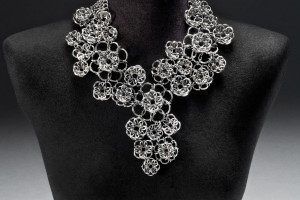 YES! I would say to anyone, don’t ever bother trying to photograph your work yourself for the purpose of getting juried into a show. (These are the product photos that I have with the standard gradient black/gray background.) The cost is not bad, relatively speaking, and well worth the money you can potentially make at a big show. You get one try a year to apply for each show, so skimping on the photography is not a good idea. There are a handful of photographers that specialize in artist jury photos that can easily be found online.
YES! I would say to anyone, don’t ever bother trying to photograph your work yourself for the purpose of getting juried into a show. (These are the product photos that I have with the standard gradient black/gray background.) The cost is not bad, relatively speaking, and well worth the money you can potentially make at a big show. You get one try a year to apply for each show, so skimping on the photography is not a good idea. There are a handful of photographers that specialize in artist jury photos that can easily be found online.
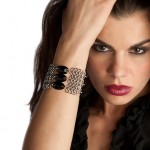 As far as my website photos with models, I have those done by my friend, Audrey Keller (http://www.akphotodesign.com). We met at an art fair in 1999 and traded art for service, and have been working together ever since! It is a huge expense, so I only do one big shoot a year, but the results are fantastic. And as a lot of you know, photographing chainmaille is difficult since it really takes on its most striking characteristics when worn on a form, the body. Photographing chainmaille flat doesn’t really do it justice most of the time!
As far as my website photos with models, I have those done by my friend, Audrey Keller (http://www.akphotodesign.com). We met at an art fair in 1999 and traded art for service, and have been working together ever since! It is a huge expense, so I only do one big shoot a year, but the results are fantastic. And as a lot of you know, photographing chainmaille is difficult since it really takes on its most striking characteristics when worn on a form, the body. Photographing chainmaille flat doesn’t really do it justice most of the time!
Have you ever had to prove your work is ART to the art world?
That whole idea of proving art…bah! I guess I’ve felt like over time I’ve had to prove that my work is art – not verbally, but just by continuing to work to achieve my goal and stick to my guns. I was told when I started that people would really never see the value in my work as long as I worked in stainless because it wasn’t a precious metal. I always thought that was so ridiculous. My jewelry can’t be of value because I’m not shelling out a ton of money for the material and therefore can’t charge a good price because the work itself is not worthy enough? Somehow using sterling or gold and increasing the price accordingly would sell better and automatically make something respectful? I think as long as your talent shows, and you have good craftsmanship and just simply make something beautiful, or something that just speaks to someone, it is art, and it is worthy of respect.
Have you ever been rejected from Art Shows?
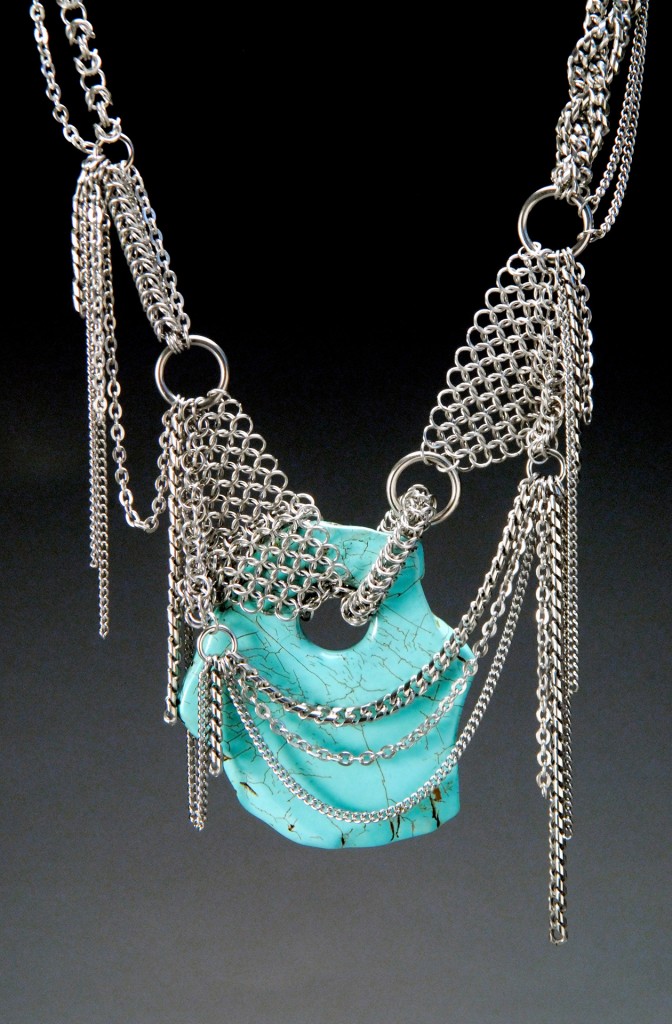 Omg, yes! NO one is immune. In fact, I got 2 major rejections this year that are huge blows to my income. This time of year is VERY stressful for artists because we are anticipating our show notifications, and our livelihoods are in the hands of strangers. Some shows “grandfather” you in (once you get accepted, you’re pretty much guaranteed in every year), some will jury on site and extend an invitation for next year’s show, and some you just NEVER know. The juries supposedly change every year, so you always have a different set of eyes viewing your work. And then of course there’s politics. Shows won’t admit to it, but there is favoritism for different situations.
Omg, yes! NO one is immune. In fact, I got 2 major rejections this year that are huge blows to my income. This time of year is VERY stressful for artists because we are anticipating our show notifications, and our livelihoods are in the hands of strangers. Some shows “grandfather” you in (once you get accepted, you’re pretty much guaranteed in every year), some will jury on site and extend an invitation for next year’s show, and some you just NEVER know. The juries supposedly change every year, so you always have a different set of eyes viewing your work. And then of course there’s politics. Shows won’t admit to it, but there is favoritism for different situations.
Also, you need to have back-up shows. Unless you get an automatic invite, no show is guaranteed. Artists that do this hardcore for a living might have 2 or 3 back-up shows that they apply to for certain weekends, and hope it all balances out.
One reader wrote: “I probably just need a different craft fair, but at my last one I got no sales, and people said either ‘that’s for teenagers’ or ‘I already spent my money for today’/’that’s too expensive’. How do you respond to those kinds of problems?”
Oh boy, that’s difficult. The simple answer is “yes, you’re doing the wrong shows.” I guess you should ask yourself “why?” to all of these responses. “That’s for teenagers.” Why are they saying this? Maybe the answer is that you SHOULD be marketing to teenagers (nothing wrong with that!), or on the other spectrum tweaking your designs so that they appeal to a larger age group. “I already spent my money today.” Why did they spend their money elsewhere? What are other artists doing that make people buy their work? “That’s too expensive.” Why do they think my work is too expensive? Is this crowd not educated about the artistry involved in my work? Is this crowd just looking for “deals?” If your work is labor intensive and therefore expensive, you shouldn’t be at shows where the patrons don’t “get it.”
As far as responding to these problems, it can be frustrating. I find that if you start explaining to someone why your prices are what they are, they don’t have the patience or care to listen to the answer, and then you just feel like your giving excuses that people don’t seem to trust or something like that. The best response is to just smile, or say, “Well, thanks for taking the time to stop by and check out my work.” I’m not going to pretend like I’m positive all the time (far from it at times), but it is the best policy. If people don’t get it, most likely they won’t get it. Time to move on. Hopefully someone will come by that will get it, and they are the ones who should have your work anyway.
In addition to selling your work at shows you also have wholesale accounts with vendors. What do you think was the key to getting your first few wholesale accounts and what do you do from a customer service standpoint to keep those customers?
 Again, I’m not going to lie and pretend I’m on top of things all the time. Seriously, most of my wholesale accounts have found me or “fallen into my lap” somehow. This is mostly because I concentrate on the retail aspect of my business because it is more profitable, and I enjoy the shows. About 75-85% of my yearly income is retail sales. That being said, I will not discount how important it is to have a good batch of solid wholesale accounts, because for me, they help me through the “down time” and help me reach more people. If you’re just starting and seeking wholesale accounts, do some research on stores where your work might fit in well as far as price points and general aesthetic. Ask people where they shop and where they think your work would fit well. Make phone calls, send emails, send postcards. Remember that buyers are really hectic and busy, so be respectful of that. When you call, ask when would be a good time for them to talk and make an appointment. Cold calling a store may get a cold reception.
Again, I’m not going to lie and pretend I’m on top of things all the time. Seriously, most of my wholesale accounts have found me or “fallen into my lap” somehow. This is mostly because I concentrate on the retail aspect of my business because it is more profitable, and I enjoy the shows. About 75-85% of my yearly income is retail sales. That being said, I will not discount how important it is to have a good batch of solid wholesale accounts, because for me, they help me through the “down time” and help me reach more people. If you’re just starting and seeking wholesale accounts, do some research on stores where your work might fit in well as far as price points and general aesthetic. Ask people where they shop and where they think your work would fit well. Make phone calls, send emails, send postcards. Remember that buyers are really hectic and busy, so be respectful of that. When you call, ask when would be a good time for them to talk and make an appointment. Cold calling a store may get a cold reception.
As far as customer service, and how to deal with buyers, my general feeling is that you should definitely do what you can to keep the buyer happy HOWEVER, I will not deal with overly difficult buyers (and they are out there). From experience, the frustration is not worth the money. Also, from experience, I have learned to HAVE POLICIES AND STICK TO THEM. I might have the luxury of turning away a nightmare account (someone who is very difficult or who can’t follow my reasonable policies) because wholesale is a smaller aspect of my business. Your business might rely entirely on wholesale and you might want to be more lenient. I just find that letting a buyer walk all over you in the beginning just invites trouble down the line and does nothing for your confidence as a business owner.
It’s always inspiring to see someone “make it” doing what they love but it’s no secret it takes an incredible amount of work to make that happen. How do you handle the pressure of being a professional jewelry artist?
Do I handle it? Lol. Sometimes, honestly, I don’t. I get panic attacks, I get short of breath sometimes. I’ll be the first to admit I don’t handle stress very well, but I try to keep myself in check and try not to take it out on other people (which is how it usually presents itself). I have goals to try to exercise more, to try meditation, to deal with my perfectionistic OCD. But the one thing I will say with conviction is this: NETWORK. Find people in the same situation as you. Talk to people. I will say this in general, even if you’re not stressed out. Networking and talking to other artists can be extremely educational, extremely satisfying, and extremely de-stressing. If you have a question about the business, I can say that most artists will open up their hearts to you to help out, and it is hands down the best way to learn. There may be some people out there who will want to guard certain information, and you have to be respectful of that – there is a ton of competition out there and it is only growing. But having a glass of wine with an artist friend, sharing experiences, venting, etc is SUPER cathartic. I suggest starting a group of local artists in your area who meet regularly to share and hang out. It’s the best!
What goals do you set for yourself each year to either improve on your art or make your business more successful?
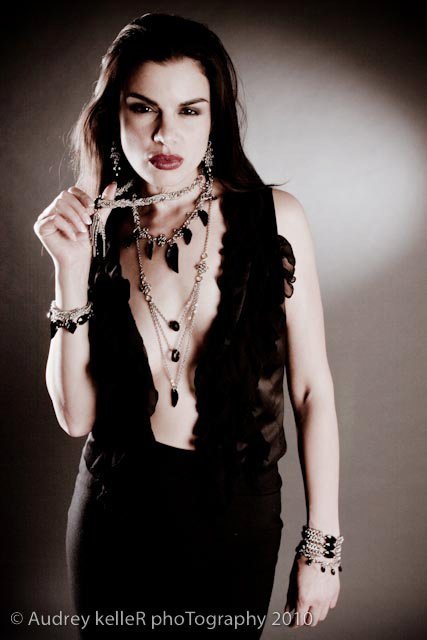 Well, I try to design a new collection at least once a year, and design other new things here and there throughout the year. It is very important to keep your product fresh. Regular customers are your bread and butter, and they want to come to your booth or your store to see your newest creation, not the same thing over and over. I do keep my best sellers around for years and years, but if something sits for too long, stop making it and move on!
Well, I try to design a new collection at least once a year, and design other new things here and there throughout the year. It is very important to keep your product fresh. Regular customers are your bread and butter, and they want to come to your booth or your store to see your newest creation, not the same thing over and over. I do keep my best sellers around for years and years, but if something sits for too long, stop making it and move on!
The other thing is improvements in design or materials, and I only do this when I can afford it – that has been my approach to my business – I only spend money when I have it. I have never had a business credit card, I’ve never had an official loan. So my business has grown slowly, but steadily, and without the stress of debt. So maybe next year I will use some of my profit to get better findings made, etc. It’s just all about improving your craftsmanship and growing when you can grow.
What aspect of your business reaps the biggest financial reward – art & craft fairs or wholesale orders? What reaps the biggest personal reward (that is, what brings you the most joy)?
Shows and shows. Art fairs are most profitable because you are selling at retail, but that extra money will also pay for gas, hotel, booth fees, and the extreme exhaustion of dealing with long hours, being outdoors all day in heat, wind, rain, cold, tornado warnings, you name it. But I can officially say I am an art show addict. I love it. I do. There is something about working your butt off and living through hardships that really, really pays off and brings so much joy on the other side. I guess it’s similar to how I feel about getting tattooed. Temporary pain brings permanent beauty.
Thank you so much for being part of our “Ask an Artist” series – based on the response we got from our readers, your work is a true inspiration to many people. On that note – one final question: How do you come up with your designs, what inspires you?
There are many different ways I come up with designs. A lot of the time my designs are dictated by the material. I am constantly on the hunt for stainless steel components to incorporate with chainmaille (or other things I think will go well with stainless). For example, if I find a certain chain style, I will design around it, or a certain stone…the feel of that object will decide the style of the design, and I play around with what I can do with it.
I may also be inspired by other jewelry I see that is completely different than mine and think – how can I re-create that in chainmaille? For example, the pen necklace that Joan’s character on Mad Men always wears….I tried to create a loose interpretation of this that became the Spike Pendant in the Metal Collection. It’s a fun challenge to use chainmaille to re-create a form that sticks in your mind.
 Sometimes I feel like I will need to fill a void in a collection and design something to fill that void. For example – this one certain collection doesn’t have any long necklace options – what can I design that will be long, but still compliment the other pieces in the collection? I guess I do design a lot to make my collections and displays appeal to a lot of people, to feel like a complete line of jewelry. Another important thing to ask yourself is – how accessible is my jewelry to a wide spectrum of people? Do I really want to be a niche product? I feel like chainmaille can be a niche item, but it doesn’t have to be! And we all know it’s getting more and more trendy, a fact that I have a love/hate relationship with. The point is that I try to have a piece of jewelry for a petite, conservative woman, as well as a piece for someone who thinks, the bolder, the better – and I design with that purpose in mind. “Something for everyone” translates to more happy people, more customers, and more sales.
Sometimes I feel like I will need to fill a void in a collection and design something to fill that void. For example – this one certain collection doesn’t have any long necklace options – what can I design that will be long, but still compliment the other pieces in the collection? I guess I do design a lot to make my collections and displays appeal to a lot of people, to feel like a complete line of jewelry. Another important thing to ask yourself is – how accessible is my jewelry to a wide spectrum of people? Do I really want to be a niche product? I feel like chainmaille can be a niche item, but it doesn’t have to be! And we all know it’s getting more and more trendy, a fact that I have a love/hate relationship with. The point is that I try to have a piece of jewelry for a petite, conservative woman, as well as a piece for someone who thinks, the bolder, the better – and I design with that purpose in mind. “Something for everyone” translates to more happy people, more customers, and more sales.
Doing this for a living requires that you learn SO many hard lessons, but it is necessary to grow. Just keep asking yourself “why” all the time when something doesn’t seem to work, try to scrutinize it, learn from it and then improve it. And stay confident in your work – always!
=========================================
Learn more about Melissa/Rapt in Maille:
Website: http://raptinmaille.com
Facebook page: http://www.facebook.com/raptinmaille
Twitter: http://twitter.com/raptinmaille
Blog: http://raptinmaille.blogspot.com/
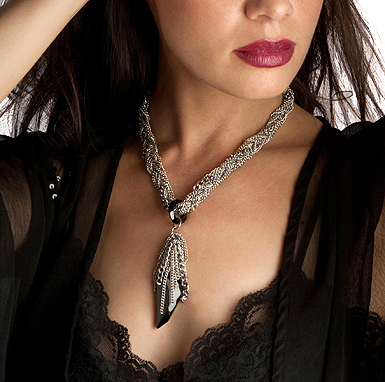





loved the cuff.. the lock most of all .. made a cuff but used lobster claws would love something like that one